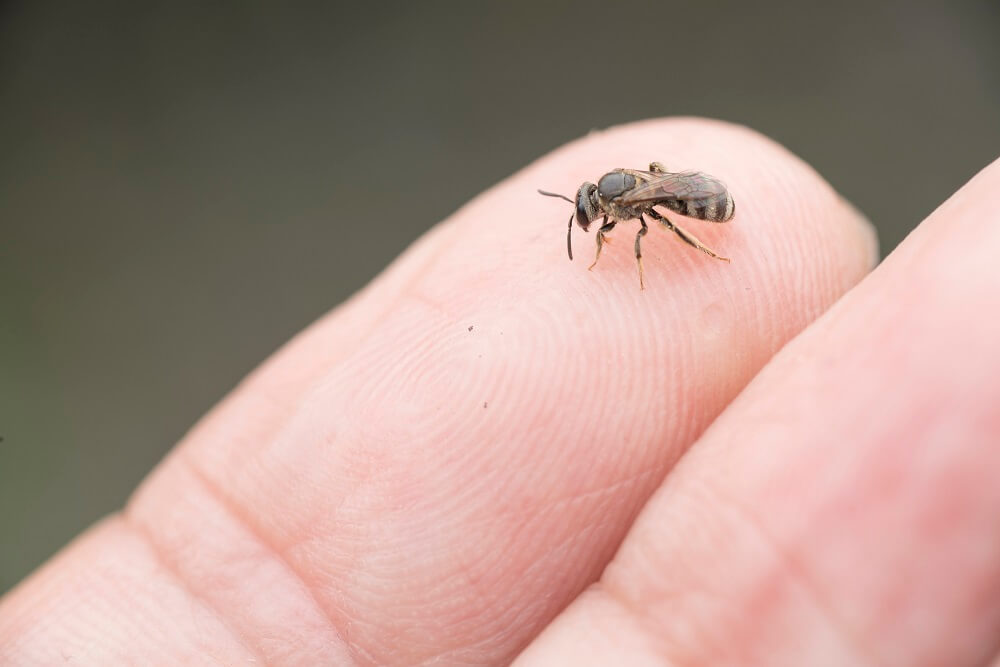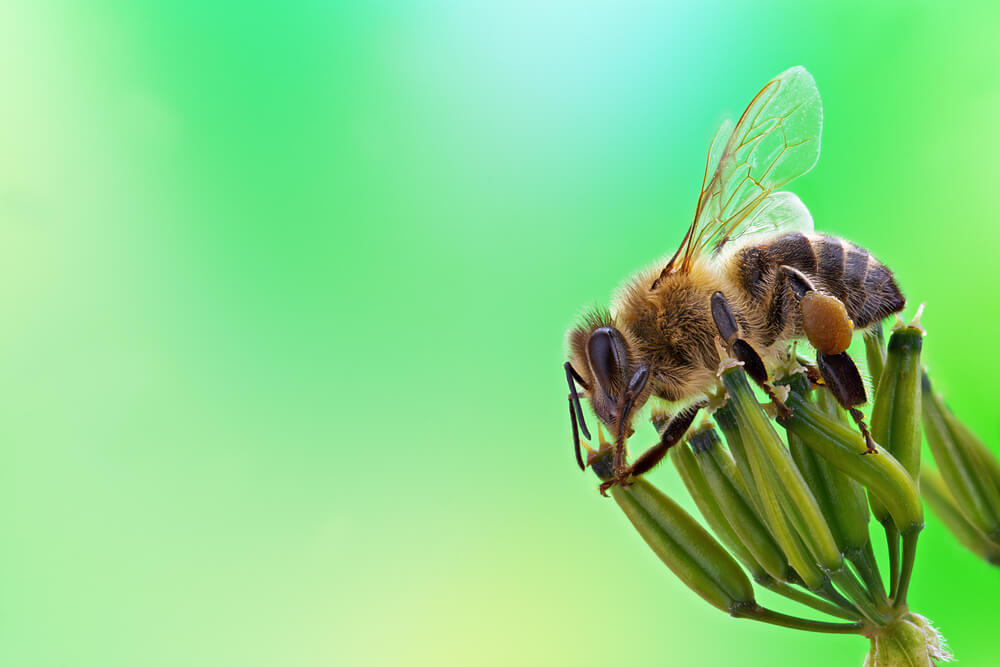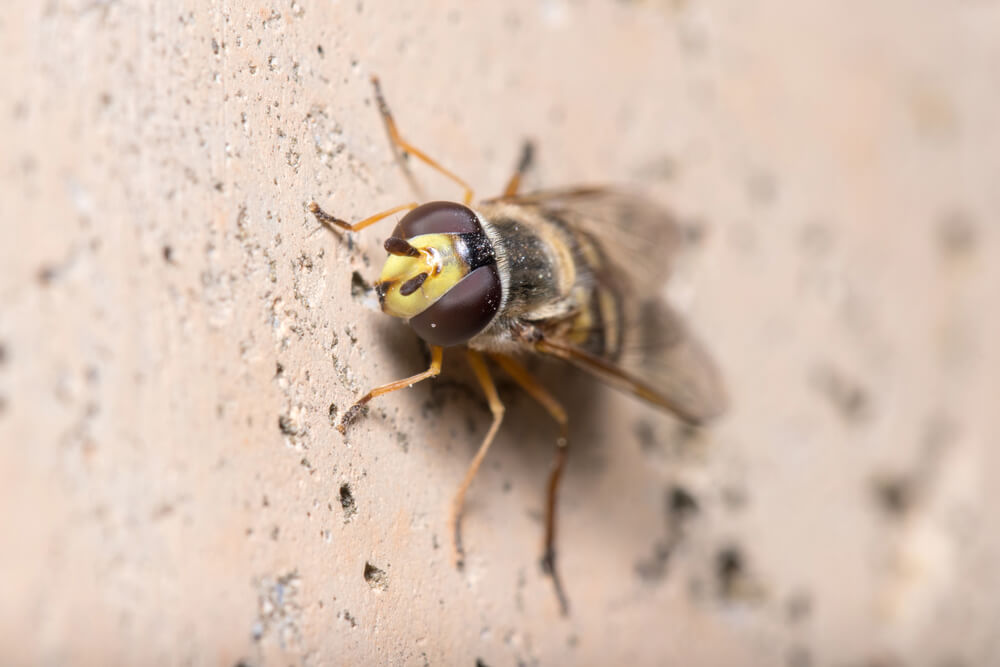Table of Contents:
Do Bees Sting?
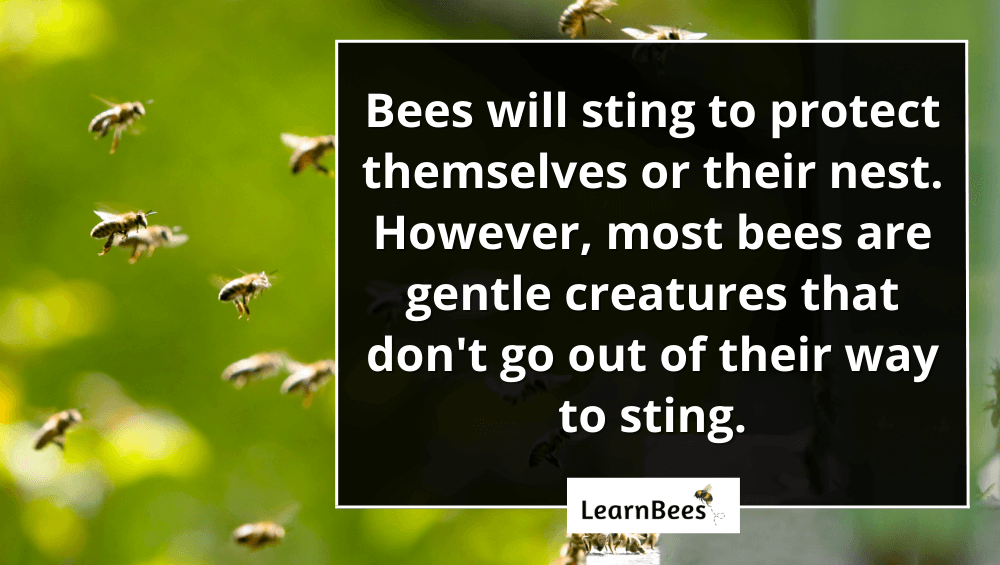
Bees can and will sting when necessary.
You might get stung by a bee if you touch it, swat it, or get too close to its beehive. Bees get defensive over these things because they have many predators to watch out for. Birds, raccoons, skunks, and bears are all out for bees or their honey.
In fact, a bear can destroy an entire honey bee hive in a matter of minutes. As a result, the honey bees have to rebuild their whole lives work after losing their hive.
So with that in mind, bees will sting to protect themselves.
But here’s the thing:
Sometimes bees mistakenly sting humans even when we come in peace. For example, you may stumble upon a beehive without realizing it. Next thing you know, you feel a sharp pinch in your arm.
That’s a bee sting. It’s unfortunate, but it’s a part of nature. Bees and humans don’t speak the same language, so you can’t exactly communicate to them that you mean no harm.
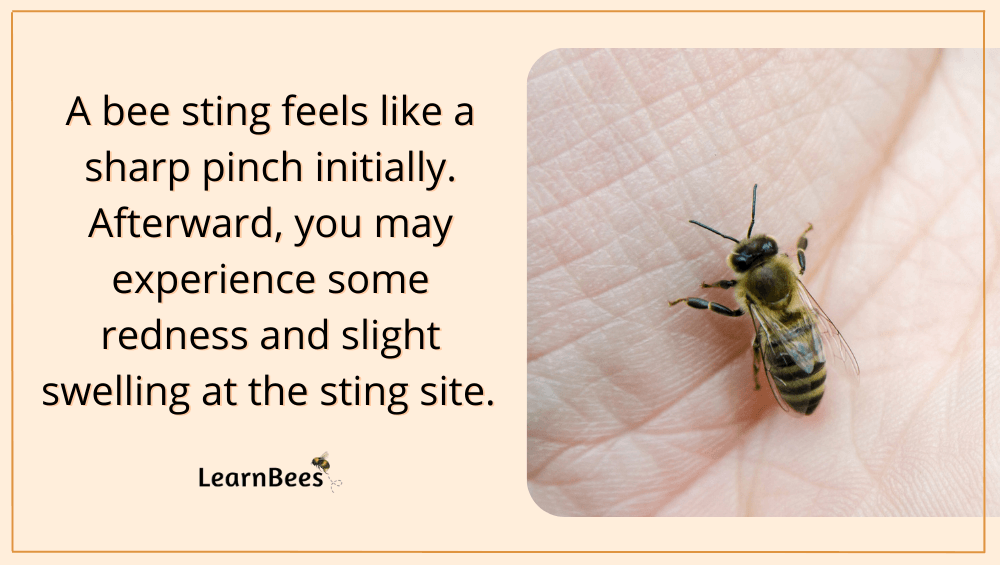
But the good news?
Bees won’t go out of their way to sting you. In fact, most bees will ignore you while they’re happily buzzing around flowers. This is because they’re away from their hive and aren’t in defense mode.
Plus, bee stings aren’t as painful as you might think.
You might feel a slight pinch followed by a sharp pain initially. Then you’ll experience some redness that disappears within 24 hours. After that, you should be back to normal as long as you aren’t allergic to bee stings.
Now here’s something that might surprise you:
Not all bees can sting.
Male bees, for example, don’t have stingers like female bees do. As a result, they can’t sting to protect themselves or their hive. Stingers are modified egg-laying organs, so only female bees have them.
Additionally, there are species of stingless bees. While female stingless bees do have stingers, they’re too tiny to be useful. Instead, stingless bees will often bite to protect themselves.
Do Bees Sting in the Winter?
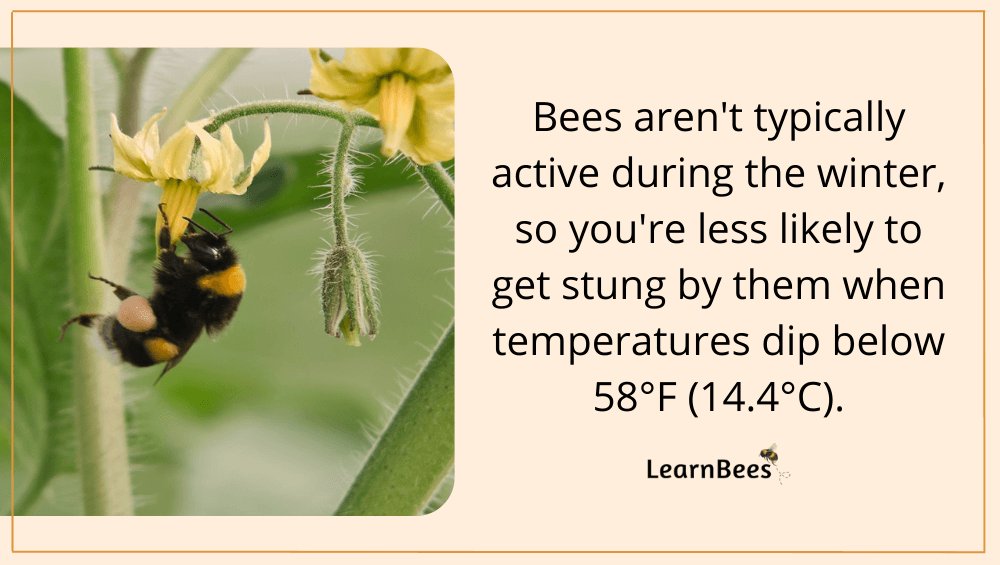
It’s rare to get stung by a bee in the winter.
Most bees hibernate during the cold months. Bumble bees, mason bees, and carpenter bees are all examples of bees that hibernate.
Bees are cold-blooded creatures that don’t thrive in harsh winters. This means little to no bees are out buzzing around during the cold, so there are fewer chances of getting stung.
With that in mind, honey bees are one of the few bee species that don’t hibernate. Instead, they huddle together inside their hive to keep warm. As such, honey bees also aren’t out and about during winter.
But there is an exception to this.
Warmer climates can allow bees to stay active year-round. For example, people who live in Florida or California may experience mild winters that rarely dip below 58°F (14.4°C).
So in warmer climates, bees are more active, which raises the possibility of bee stings.
How Do Beekeepers Not Get Stung?
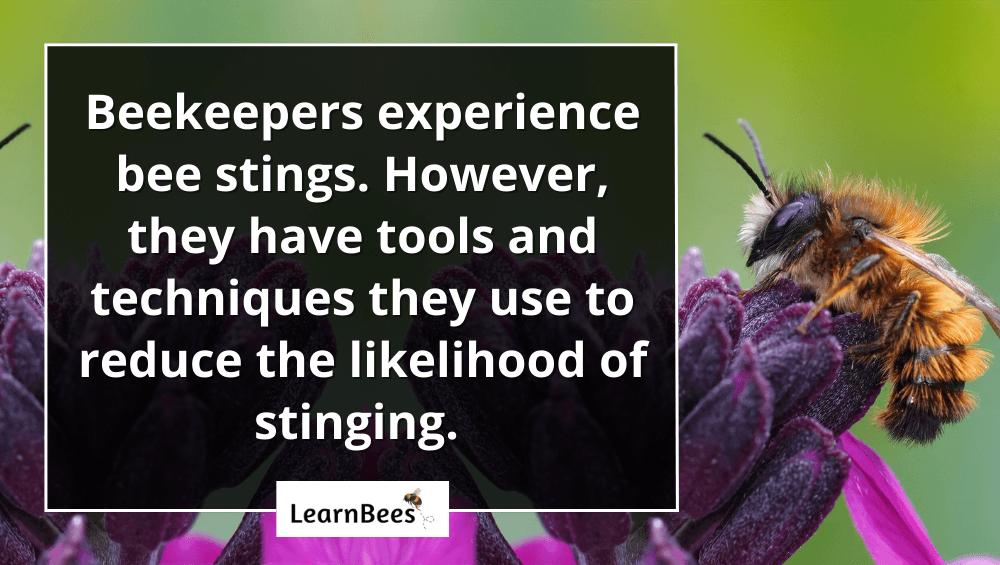
Beekeepers do get stung. It’s part of the job.
Fortunately, beekeepers can reduce the likelihood of getting stung by using tools to their advantage. Beekeeping suits and bee smokers are two common tools used to limit the number of bee stings.
Additionally, there are a few tricks of the trade to help prevent bee stings.
For example:
- Beekeepers can try to inspect hives during warm, sunny weather. Honey bees are active when the weather is nice. This means they’re outside their hive, foraging for nectar and pollen from flowers. As such, this gives beekeepers fewer bees to contend with, thus reducing the likelihood of stinging.
- Beekeepers don’t walk in front of the hive entrance. Instead, beekeepers walk around the side or back of the hive. The front of the hive is where bees are most active, so they don’t like to be blocked while they’re flying in and out of the hive.
- Beekeepers remain calm and use gentle movements. Swatting or reacting quickly can startle bees and put them in defense mode. Experienced beekeepers are comfortable performing hive inspections, so they can remain calm and work methodically.
Taking bee stings is an inevitable part of a beekeeper’s job. This is why it’s not uncommon for beekeepers to build up a tolerance to bee stings. The first few stings hurt but gradually become less painful as the beekeeper gains more experience.
More importantly?
Not all honey bee hives are the same. Some are more gentle and passive, while others are more protective and territorial. Beekeepers learn their bees’ temperaments and act accordingly.
That’s why it’s not uncommon to see an experienced beekeeper wear little to no protective gear when inspecting their hive.
We do recommend wearing bee suits. Or, at the very least, wear a beekeeping veil to protect your head and neck. Taking stings to the face is no fun.
FAQs on “Do Bees Sting?”
- How likely is a bee to sting you?
- Can a queen bee sting you?
- Will a bee sting you if it lands on you?
- What to do if a bee is chasing you?
- Do bees chase you if you run?
- What attracts bees to humans?
- Can a bee sting twice?
- Why do bees fly in your face?
- Should you jump in the water if attacked by bees?
- Should I be scared of bees?
- Do bees actually sting?
- Can bees sting through jeans?
- Will a bee sting you if you don’t move?
- Do bees sting throughout the year?
How likely is a bee to sting you?
Not likely at all.
Despite popular belief, bees are mostly passive insects that aren’t aggressive. That’s why it’s not uncommon to see bees working alongside other pollinators, such as hummingbirds or butterflies.
So if you respect a bee’s space and don’t poke around their hive, they’ll most likely leave you alone. For example, I feel comfortable gardening in my yard while happy bees buzz around me.
—> Go back to the FAQs on “Do Bees Sting?”
More to Explore:
- What Does a Bee Sting Look like?
- Do Bees Die When They Sting?
- The Best Essential Oils for Bee Stings
Can a queen bee sting you?
Yes, queen bees of most bee species can sting.
For instance, both queen bumble bees and queen honey bees can deliver stings. However, it’s rare that queen bees sting because they mostly stay inside of their hive under the protection of the worker bees.
The most common bees you see out buzzing around are worker bees. Worker bees are responsible for foraging for food, building and repairing the hive, and defending the hive from predators.
Since worker bees regularly leave the hive, they’re the most likely to sting you if they feel threatened.
—> Go back to the FAQs on “Do Bees Sting?”
More to Explore:
Will a bee sting you if it lands on you?
It depends. If you’re within a few feet of their hive, they’re more likely to sting you if they land on you.
However, if you’re away from their hive, then it’s unlikely that they’ll sting you if they land on you. Bees are usually only in defense mode when they’re close to their hive.
If a bee lands on you, you can gently brush it away with your hand or wait until it flies away on its own.
—> Go back to the FAQs on “Do Bees Sting?”
More to Explore:
- Do Carpenter Bees Sting?
- How to Remove a Bee Stinger Stuck Under Skin
- The 10 Best Flowering Trees for Bees
What to do if a bee is chasing you?
If a bee is chasing you, it’s likely because you’ve disturbed their hive or they think you’re a predator.
The best thing you can do is stay calm and get as far away from the bee as possible. In most cases, a bee won’t chase you more than a few feet away from its hive.
Also, keep in mind:
Sometimes it can appear that a bee is chasing you when it isn’t. Bees buzz around constantly, and sometimes you’ll be in their line of sight without realizing it.
—> Go back to the FAQs on “Do Bees Sting?”
More to Explore:
Do bees chase you if you run?
Bees are not more likely to chase you just because you’re running. They’ll usually only chase you if you get too close to their hive. Bees are typically gentle creatures that don’t go out of their way to sting or chase people.
—> Go back to the FAQs on “Do Bees Sting?”
More to Explore:
What attracts bees to humans?
People sometimes ask, “What attracts bees to a person?”
There are a few things that might temporarily attract bees to you:
- If you’re wearing brightly colored clothing
- If you’re wearing sweet-smelling perfume or cologne
- If you’re eating or drinking something sweet
However, bees will quickly realize you aren’t what they’re looking for once they land on you. So they’ll fly away in search of a flower.
—> Go back to the FAQs on “Do Bees Sting?”
More to Explore:
Can a bee sting twice?
Most bee species can sting multiple times without dying.
Remember:
There are over 20,000 bee species, including honey bees, bumble bees, and carpenter bees. Bumble bees and carpenter bees are examples of bees that can sting twice or more.
However, honey bees are the exception. Honey bees can’t sting twice because they lose their stinger in the process. Their stinger is a vital organ. Once they lose it, they die shortly after.
—> Go back to the FAQs on “Do Bees Sting?”
More to Explore:
Why do bees fly in your face?
If a bee is consistently buzzing around your face, it’s a sign that you may be close to their nest. Walk away quickly to give them some space.
With that in mind:
If you walk away more than 10 feet and they continue to buzz at your face, you might be mistaking them for a different insect. For example, some people may mistake horseflies for bees. Horseflies seek out people to bite them to ingest blood.
Bees, on the other hand, don’t typically follow you once you’re away from their hive.
—> Go back to the FAQs on “Do Bees Sting?”
More to Explore:
Should you jump in the water if attacked by bees?
No, the best thing to do is run away as fast as possible. If you can, seek protection from enclosed shelters such as a car or house.
The biggest “bee threat” to humans is Africanized honey bees. These bees are more aggressive than other honey bee species. They will swarm and chase you for long distances.
Africanized honey bees have been known to chase people up to a quarter-mile away from their hive.
—> Go back to the FAQs on “Do Bees Sting?”
More to Explore:
Should I be scared of bees?
You should be cautious and respectful of bees, not scared of them.
Most bees are passive-natured and won’t go out of their way to harm you. They’re busy little creatures that are focused on their daily tasks. As such, they don’t take time away from their day to attack people randomly.
With that in mind, it’s smart to be aware of any bee nests or hives on your property. If you have hives close to your pets or humans, consider calling a local beekeeper to relocate the hive safely.
—> Go back to the FAQs on “Do Bees Sting?”
More to Explore:
- Ground Bees: Are They a Threat to Your Yard?
- Wasps vs. Honey Bees: Are They Different?
- Do Bumble Bees Bite?
Do bees actually sting? Can bees sting?
Yes, female bees can sting. Male bees cannot. Also, some species of bees don’t sting. These are called “stingless bees.”
—> Go back to the FAQs on “Do Bees Sting?”
More to Explore:
- Do Carpenter Bees Pollinate?
- How Long Do Bumble Bees Live?
- Honey Bees vs. Bumble Bees: How Do They Compare?
Can bees sting through jeans?
Yes, bees can sting through clothing. They can also sting through thin shoes and other protective gear.
The best way to avoid being stung is to be aware of your surroundings. If you see a bee nest or hive, stay away from it. Bees need plenty of space to feel safe from predators.
—> Go back to the FAQs on “Do Bees Sting?”
More to Explore:
Will a bee sting you if you don’t move?
It depends on how close you are to their nest.
If you’re far away from their nest, they’re probably just landing on you for a break from flying. They should fly away within a few seconds.
If they don’t fly away, gently brush them away with your hand. You can also start walking, which allows your body movement to encourage the bee to fly away.
On the other hand, if you’re close to their nest, your chances of getting stung when they land on you are higher. As such, quickly walk away from the area to give the bees the space they need to feel comfortable.
—> Go back to the FAQs on “Do Bees Sting?”
More to Explore:
Do bees sting throughout the year?
Most bee species are active during the spring, summer, and fall.
As such, bees can sting during these months because they have more contact with humans and other predators. Bees don’t typically sting during the winter because they’re inside their nest until spring emerges.
Some bee species, like bumble bees, hibernate until the weather warms up. Other bee species, like honey bees, remain in the hive clustered together to stay warm until spring.
Also, the winter habits of bees depend on your climate. For example, bees can be more active year-round in warm climates like Australia or South America.
